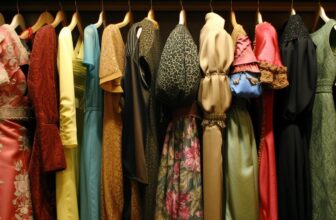
Dress Code for Celebration of Life
The celebration of life is a special event held to honor the memory of a loved one who has passed away. It is a time for family and friends to come together, share memories, and celebrate the impact the deceased had on their lives. One important aspect of this commemoration is the dress code, which serves as a way to show respect and honor for the individual being remembered.
The dress code for a celebration of life is a subtle but significant way to pay tribute to the deceased. It reflects the solemnity and reverence of the occasion while also acknowledging the joy and love that characterized their life. Understanding the significance of this dress code can help attendees approach the event with thoughtful consideration.
Traditionally, black attire has been a common choice for mourning in Western cultures. However, modern celebrations of life have seen a shift towards incorporating colorful or even themed clothing that reflects the personality and interests of the departed individual. This change reflects a desire to focus on honoring their unique spirit rather than adhering strictly to traditional expectations.
In addition to personal preference, different cultures may also have specific customs and traditions regarding appropriate attire for honoring those who have passed away. Understanding these cultural nuances can help guests show respect in accordance with those customs.
For immediate family members, there may be specific expectations regarding dress code that go beyond what is expected from other guests. This can include coordinating colors or specific accessories that hold personal significance. Similarly, friends and distant relatives may also be guided by certain etiquette when selecting their attire.
Children attending a celebration of life event should be dressed appropriately for their age while still respecting the tone of the occasion. Parents may need to consider what would be both respectful and comfortable for them during what could be an emotionally taxing event.
Despite these different considerations, personalizing one’s dress code should ultimately reflect how one wishes to honor and remember their loved one. Incorporating specific requests from the deceased or adding personal touches can add meaningful depth to one’s attire and contribute to creating an atmosphere that honors their memory in a thoughtful way.
Importance of Dress Code
The dress code for a celebration of life holds a significant importance as it serves as a way to honor the memory of the deceased. In many cultures, what you wear to such an event is seen as a sign of respect and a way to show your love and appreciation for the person who has passed away. The clothing you choose can also convey the mood of the gathering, whether it be somber and reflective or joyous and celebratory.
Elevating the Meaning
A dress code for a celebration of life elevates the importance of the occasion, setting it apart from other gatherings. It signifies that this is not just any event, but one that holds particular significance in honoring the life and legacy of someone special. By adhering to a designated dress code, individuals are paying tribute to the departed in a tangible and visible way.
Reflecting Personal Values
The way we dress often reflects our personal values, beliefs, and respect for certain traditions or customs. By following a dress code for a celebration of life, attendees are able to express their reverence for the deceased while honoring their family’s wishes for how they’d like their loved one to be remembered.
Creating Unity Among Attendees
A designated dress code has the ability to create unity among attendees by providing everyone with clear expectations regarding attire. When everyone dresses according to a common standard, it helps foster an atmosphere where all present feel included and connected in showing their respect for the person being honored.
Expressing Love and Gratitude
Choosing appropriate attire speaks volumes about an individual’s love and gratitude towards the departed. The effort put into dressing respectfully sends a powerful message about how much they meant to those attending the celebration of life. It also serves as a form of comfort and solidarity for grieving loved ones, knowing that their family member or friend was held in high esteem by so many people.
Traditional Dress Code for Celebration of Life
When attending a celebration of life, it is important to consider the traditional dress code that is often expected. The attire for these events is typically more formal than what one might wear to a casual gathering, as it is a way to honor the memory of the deceased.
Common attire for men includes suits or dress shirts and slacks, while women often opt for dresses or formal pantsuits. It is important to keep in mind that the focus should be on being respectful and tasteful in your choice of clothing.
One common feature of traditional dress codes for celebrations of life is the color black. Black clothing is often associated with mourning and is therefore a common choice for these occasions. However, some families may request that attendees wear brighter colors as a way to celebrate the life of their loved one rather than solely mourn their passing. It is always best to follow any specific requests made by the family regarding attire.
Accessories also play a role in traditional dress codes for celebrations of life. For women, wearing a hat or fascinator can be a way to show respect and add an elegant touch to their outfit. Men may choose to wear ties or pocket squares in darker colors as a nod to tradition.
It’s important to remember that while there are certain traditions surrounding dress code for celebrations of life, they can vary depending on cultural or religious customs. For example, some cultures may have specific requirements for modesty or certain types of clothing that are considered appropriate for mourning. It’s essential to be mindful and respectful of these differences when attending such events.
| Attire | Significance |
|---|---|
| Black clothing | Associated with mourning |
| Brighter colors | Celebrating the life of the deceased |
| Hats/fascinators | Show respect and add an elegant touch |
Modern Dress Code for Celebration of Life
Over time, the dress code for celebrations of life has evolved to become more flexible and inclusive. In the past, traditional attire such as all black clothing was commonly expected at these events. However, as society has changed, so has the approach to dress codes for such occasions.
Modern dress codes for celebrations of life now often encourage guests to wear attire that reflects the personality and interests of the deceased. This can include incorporating their favorite colors, patterns, or even dressing in clothing that represents a hobby or passion they had. This evolution in dress code allows for a more personalized and meaningful approach to honoring the memory of the departed.
In addition to this shift towards personalization, there has also been a move towards embracing diversity and cultural norms when it comes to dress code for celebrations of life. Guests from different cultural backgrounds may have specific attire or customs associated with mourning and remembrance, and it is important to acknowledge and respect these traditions.
There is also a trend towards casual or business casual attire being accepted at celebrations of life. Many families recognize that not everyone owns traditional mourning clothing and want to create an atmosphere that is welcoming and comfortable for all guests. Some people choose to celebrate their loved ones’ lives with colorful clothing or symbolic accessories rather than adhering to classic funeral attire.
Overall, the modern dress code for celebrations of life aims to create an inclusive environment where guests can pay their respects in a way that feels authentic and meaningful to them. It allows for flexibility while still honoring the memory of the deceased in a respectful manner.
- Guidelines for modern dress code:
- Consider incorporating the deceased’s favorite colors or styles into your outfit
- Respect cultural traditions related to mourning attire if applicable
- Casual or business casual attire is often acceptable, but use discretion based on the family’s preferences
- Avoid overly flashy or revealing clothing out of respect for the solemn nature of the event
Dress Code Etiquette
Attending a celebration of life is a solemn and meaningful occasion to honor the memory of a loved one who has passed away. As such, it is crucial for guests to adhere to a dress code that reflects the significance of the event.
The appropriate attire not only pays tribute to the deceased but also shows respect for their family and friends. Understanding the dos and don’ts of dress code etiquette for these celebrations is essential to ensure that everyone is dressed appropriately.
First and foremost, it’s important for guests to remember that a celebration of life is not a traditional funeral. While black attire is commonly associated with funerals, celebrations of life often encourage guests to wear clothing that reflects the personality or interests of the deceased. It’s acceptable to wear color, patterns, or clothing that represents a hobby or passion of the person being remembered. The key is to strike a balance between respectful and celebratory attire.
Guests should also consider the location and setting of the celebration when choosing their outfit. If the event is held in an outdoor garden or park, semi-casual or semi-formal attire may be more appropriate. On the other hand, if it takes place in a religious institution or formal venue, more formal attire such as suits and dresses may be expected.
When deciding on footwear, guests should opt for comfortable yet respectful shoes. This means avoiding overly casual footwear such as flip-flops or sneakers unless specifically indicated by the family. Additionally, accessories should be kept simple and tasteful, with minimal jewelry and subdued hair and makeup.
It’s crucial for guests attending a celebration of life to avoid clothing that could potentially cause offense or distraction. This includes clothing with inappropriate language or images, overly revealing outfits, or flashy accessories that draw attention away from honoring the deceased. Ultimately, when selecting an ensemble for this type of event, guests should strive for attire that reflects reverence while also celebrating the life being remembered.
Dress Code for Family Members
Family members play a crucial role in the celebration of life, as they are the ones who are most deeply affected by the loss of their loved one. As such, there is often an unspoken expectation for family members to dress in a way that reflects the significance of the occasion and honors the memory of the deceased.
Respectful Attire
Immediate family members are expected to dress in a manner that shows respect for the departed and the grieving process of fellow family members. This typically means wearing formal or semi-formal attire that is appropriate for the setting and reflects the solemnity of the event.
Symbolic Colors
Family members may also choose to wear specific colors that hold significance for them or their departed loved one. For example, some may opt for all black attire as a symbol of mourning, while others may choose to incorporate the deceased’s favorite color into their outfit as a personal tribute.
Personal Touches
In some cases, immediate family members may choose to incorporate personal touches into their attire as a way of honoring their loved one. This could include wearing jewelry or accessories that belonged to the deceased, or even incorporating elements of their favorite hobbies or passions into their clothing choices.
Comfort and Sensitivity
While it is important for family members to adhere to a certain level of formality in their attire, it is also essential to prioritize comfort and sensitivity. The grieving process can be emotionally taxing, and wearing uncomfortable or overly restrictive clothing can add unnecessary stress to an already difficult situation. It’s important for family members to strike a balance between respectful attire and personal comfort during this time.
Social Distinction
Family members sometimes express different types of social distinction through dress code based on kinship classification such as lineage-based distinctions reflecting social status within their community.
As immediate family plays an integral role in the celebration of life, it is important for them to consider these guidelines when choosing their attire for this significant event. By dressing respectfully and with meaningful touches, they can honor their loved one’s memory while providing support and unity within the family circle.
Dress Code for Friends and Distant Relatives
When it comes to attending a celebration of life, knowing the appropriate dress code is essential. While immediate family members may have specific expectations for their attire, friends and distant relatives also need to be mindful of what is considered appropriate for such an event. Here are some guidelines to consider when selecting your outfit for a celebration of life.
First and foremost, it’s important to remember that a celebration of life is a respectful and solemn occasion. Therefore, your attire should reflect this somber tone. For friends and distant relatives, opting for formal or semi-formal attire is usually the best choice. This means wearing dark-colored clothing such as black, navy blue, or dark gray. Avoid wearing outfits with bright or bold patterns, as well as anything too casual like jeans or t-shirts.
For men, a suit or dress pants paired with a blazer is often appropriate. A collared shirt and dress shoes complete the look. Ties are optional but can add an extra touch of formality to the outfit. Women can opt for a dress or skirt with a conservative length (avoiding anything too short) paired with a blouse or sweater. Dress shoes or closed-toe heels are recommended.
It’s also important to take into account the location and any specific cultural or religious customs associated with the celebration of life. For example, some cultures may have traditional attire that is expected for such events. In these cases, it’s crucial to respect and adhere to these customs out of reverence for the deceased and their family.
Overall, the key when choosing your outfit for a celebration of life as a friend or distant relative is to show respect and consideration towards the family in mourning while paying homage to the memory of their loved one.
| Category | Attire |
|---|---|
| Men | Suit or dress pants with blazer, collared shirt, dress shoes |
| Women | Dress or skirt (conservative length), blouse or sweater, dress shoes or closed-toe heels |
| Avoid | Bright colors, bold patterns, casual clothing like jeans or t-shirts |
Dress Code for Children
When it comes to attending a celebration of life, it’s important to consider the dress code for children. While children may not fully understand the significance of the event, dressing them appropriately shows respect and honors the memory of the deceased. Whether they are immediate family members or guests, following some guidelines can help ensure that the children’s attire is respectful and fitting for the occasion.
When dressing children for a celebration of life, it’s important to consider comfort and appropriateness. For boys, a simple and modest outfit such as slacks or chinos paired with a collared shirt is typically appropriate. Avoid overly casual clothing such as t-shirts with graphics or jeans with holes. For girls, a dress or skirt paired with a blouse is suitable. It’s best to avoid loud patterns or flashy accessories and opt for more subdued colors and styles.
Younger children can be dressed in age-appropriate outfits such as rompers, dresses, or dress shirts and trousers. It’s important that their clothing allows them to move freely and comfortably as they may be participating in activities or spending time with family members during the celebration of life.
As with adult attire, it’s crucial to consider cultural and religious customs when dressing children for a celebration of life. Some cultures may have specific requirements for children’s clothing at such events, so it’s essential to be mindful of these traditions when selecting their attire.
In some cases, families may choose to honor the memory of the deceased by incorporating specific colors or symbols into their children’s attire. This can be a meaningful way to personalize their dress while paying tribute to their loved one. Whether it’s wearing a particular color associated with the deceased or including an accessory that holds special significance, personalizing their attire can be a touching way to remember the person being celebrated.
Dress Code for Different Cultures
Different cultures around the world have varying customs and traditions when it comes to celebrating the lives of their loved ones. These cultural differences are often reflected in the dress code for the celebration of life ceremonies. Understanding and respecting these cultural dress codes is essential when attending or organizing a celebration of life.
In some cultures, such as in many Asian countries, white is the traditional color worn to funerals and celebrations of life as it symbolizes mourning and purity. In contrast, African cultures may incorporate bright colors and elaborate fabrics into their attire to celebrate the vibrancy of life and honor the deceased. It is important for guests to be aware of these cultural nuances and dress accordingly to show respect for the traditions of the family and the deceased.
In Hispanic cultures, particularly in Mexico, celebrations of life may include Day of the Dead festivities where people wear colorful costumes and elaborate face paint to honor their departed loved ones. This tradition embraces a more joyful approach to remembering those who have passed away, with a focus on celebrating their lives rather than mourning their loss.
In some Native American communities, traditional regalia may be worn at celebrations of life to honor the heritage and spiritual beliefs of the deceased. This can include intricate beadwork, feathers, and other symbolic items that hold deep cultural significance.
When attending a celebration of life that incorporates different cultural elements, it’s important for guests to be open-minded, respectful, and willing to learn about these traditions. Being sensitive to these cultural differences and honoring them through appropriate attire demonstrates a genuine respect for the deceased and their family.
Ultimately, understanding how different cultures approach dress code for celebrations of life allows individuals from various backgrounds to come together in unity and solidarity as they pay tribute to those who have passed away. This expression of shared humanity can bring comfort and healing across diverse communities during times of grief.
Personalizing Your Dress Code
When it comes to celebrating the life of a loved one who has passed away, incorporating personal touches or specific requests from the deceased into your attire can add a meaningful and heartfelt element to the event. Whether it’s wearing their favorite color, sporting a specific accessory, or donning an outfit that held special significance to them, personalizing your dress code in this way can serve as a beautiful tribute to their memory.
By honoring the personal style and preferences of the deceased, you are not only paying homage to their individuality but also creating a tangible connection to them during the celebration of life. This thoughtful gesture can be deeply comforting to family members and friends as they come together to remember and honor the life of their loved one.
Incorporating personal touches into your dress code also allows for a more intimate and personalized experience, reminding everyone of the unique qualities and cherished memories associated with the departed individual. It serves as a visual representation of their impact on those around them and reflects the enduring love and respect felt for them by all who attend.
Furthermore, personalizing your dress code helps create a sense of unity and shared purpose among attendees. By collectively embracing elements that were special to the deceased, it fosters a shared connection and reinforces the significance of coming together in remembrance.
It can also act as a source of comfort for grieving individuals by providing them with an opportunity to express their love and respect through their chosen attire. Ultimately, incorporating personal touches into your dress code for a celebration of life can add depth, meaning, and warmth to an already poignant occasion.



